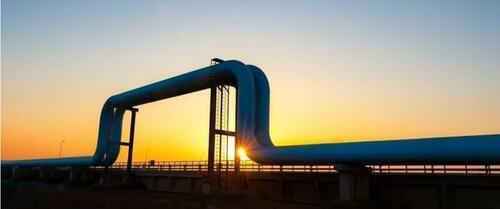
The Permian Shrugs Off Below-Zero Natural Gas Prices In Texas
By Tsvetana Paraskova of OilPrice.com

Permian producers are not shutting in oil wells with associated natural gas despite the fact that the Texas regional gas price has been stuck at below-zero levels since early March.
Major pipeline operators in the Permian basin haven’t yet seen any effect of the negative gas prices at the Waha hub in West Texas on activity as producers are look to maximize oil realizations at West Texas Intermediate crude prices at above $80 per barrel.
But the U.S. natural gas benchmark, Henry Hub, has been depressed below $2.00 per million British thermal units (MMBtu) since early February due to weak winter demand amid milder weather, record output at the end of 2023, and higher-than-average natural gas stocks.
Natural gas prices at the Waha hub slumped to a negative value of -$2.00 per MMBtu in April as the recent rise in oil prices prompted producers to bring drilled but uncompleted wells online. The Waha hub prices remained below zero for most of March and April amid high production and not enough takeaway capacity.
The price at the Waha Hub rose by $1.25 in the latest reporting week, from -$1.18/MMBtu to $0.07/MMBtu on April 24, only the second day the price was above zero since April 1, per EIA data.
The negative Waha gas prices and the supply glut are creating a problem for Permian producers regarding how they should dispose of part of the excess natural gas output.
Takeaway capacity has been constrained in recent weeks due to some maintenance, but more pipelines are set to begin operations in the coming months to potentially alleviate the glut as demand for LNG exports from the U.S. Gulf Coast will continue rising for years to come.
For the time being, the Permian is holding natural gas production relatively steady or slightly lower than at the start of the year, but rigs haven’t been dropped in the most prolific U.S. oil basin, unlike in the giant shale gas basins such as Appalachia and the Haynesville in East Texas and Western Louisiana.
„Essentially, you’ve seen no effect from the weak natural gas prices,” Anthony Chovanec, Vice President, Fundamentals and Supply Appraisal at Enterprise Products, said on the pipeline giant’s earnings call this week.
„If you look at what drives the economics of the producers in the Permian, it’s not natural gas. And, you know, you’re — what we’ve seen in natural gas prices is not going to cause people to shut in or even throttle back oil-related natural gas at this point,” Chovanec told analysts.
„But if you go and look at rig counts in the Permian, since the first of the year, they’re as steady as they can be. Actually, the same can be said for the Eagle Ford. You see rig counts down in the Haynesville and you see them down somewhat in Appalachia, but not in your oil rig basins.”
In the oil rig basins, producers aren’t rushing to boost oil production at above-$80 WTI crude prices, partly due to the weak natural gas prices. But they aren’t scaling back production, either, as they are keen to continue pumping oil and the associated natural gas that goes with it.
Some oil and gas producers in Texas have significantly increased in recent weeks the number of requests to the Railroad Commission of Texas (RRC) to allow flaring on some operations as low natural gas prices and a glut of supply present challenges to the drillers how to get rid of the unwanted gas. RRC, the oil and gas industry regulator of Texas, approved last week as many as 21 requests from producers to be exempt from rules banning or limiting flaring, Reuters reported on Tuesday.
Midstream infrastructure company MPLX expects additional takeaway capacity out of the Permian, apart from the Matterhorn pipeline expected to enter into service in the third quarter this year, MPLX’s top executives said on the earnings call this week.
„There’s going to be more takeaway out of the basin,” MPLX chief executive Michael Hennigan said.
LNG exports out of the Gulf Coast will be a major pull for natural gas produced in the Permian, MPLX’s senior vice president David Heppner added.
„You’ve got the pull coming from these LNG facilities down in the Gulf Coast, which are majority of them backstopped by 20-year take or pays, which is a nice long-term pull,” Heppner said, adding that „there is incremental capacity needed clearly with barrels out of the Permian to the Gulf Coast.”
Tyler Durden
Thu, 05/02/2024 – 14:55

 2 tygodni temu
2 tygodni temu











